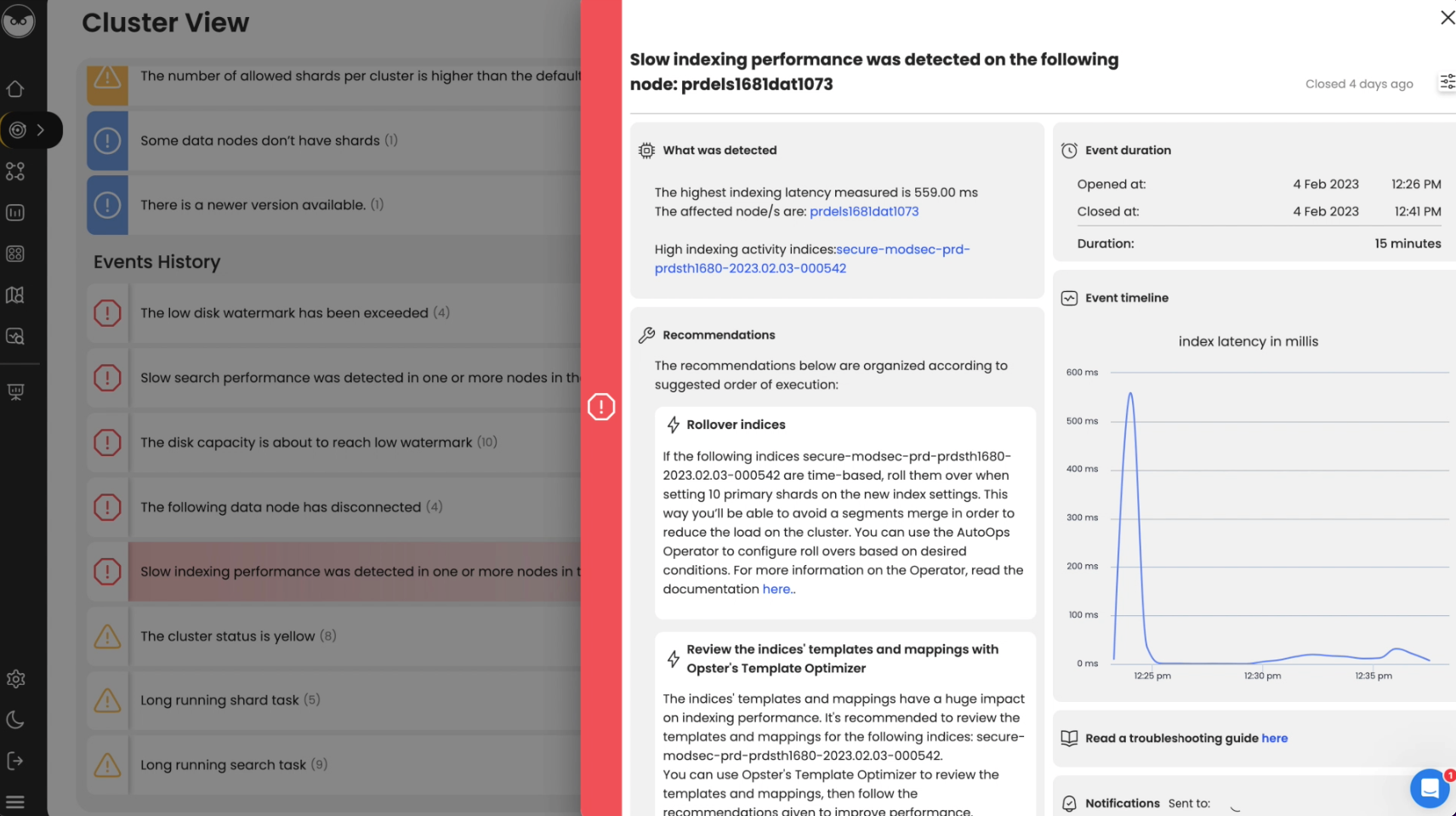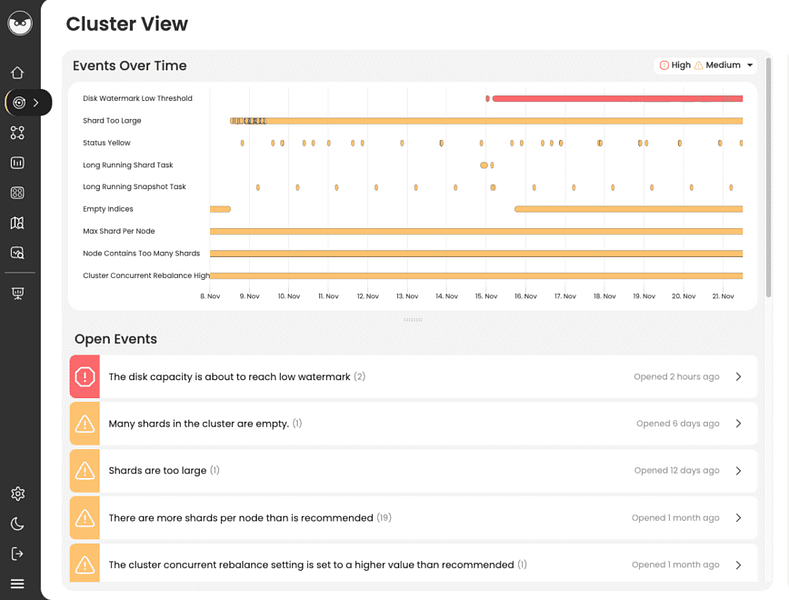Opster Team
Before you begin reading about how to address this log, we recommend you run the Elasticsearch Error Check-Up to resolve this issue and prevent others.
This guide will help you check for common problems that cause the log “adding index lifecycle policy” to appear. It’s important to understand the issues related to it, so to get started, read the general overview on common issues and tips related to the Elasticsearch concepts: index and plugin.
What the index lifecycle policy is
The index lifecycle management (commonly known as ILM) enables you to automate how you want to manage your indices over time. This will take care of automatically managing indices according to various requirements like performance, resilience, deleting old indices and retention requirements.
Refer to this documentation on ILM to learn more about this policy.
How to reproduce this log
To set up index lifecycle policy, you need to define the policy as shown below (change the policy according to your use case).
Create index lifecycle policy:
PUT /_ilm/policy/my_policy
{
"policy": {
"phases": {
"warm": {
"min_age": "10d",
"actions": {
"forcemerge": {
"max_num_segments": 1
}
}
},
"delete": {
"min_age": "20d",
"actions": {
"delete": {}
}
}
}
}
}The log generated will be:
[INFO ][o.e.x.i.a.TransportPutLifecycleAction] adding index lifecycle policy [my_policy]
What this message means
It’s an INFO message letting you know that an index lifecycle management policy is set up. The first step is to define a lifecycle policy so that the index can use this ILM policy to manage its lifecycle. The above request creates a policy called my_policy in Elasticsearch which can be later used to manage the indices. When the policy is created, Elasticsearch will log it as shown above.

Index and indexing in Elasticsearch - 3 min
Overview
In Elasticsearch, an index (plural: indices) contains a schema and can have one or more shards and replicas. An Elasticsearch index is divided into shards and each shard is an instance of a Lucene index.
Indices are used to store the documents in dedicated data structures corresponding to the data type of fields. For example, text fields are stored inside an inverted index whereas numeric and geo fields are stored inside BKD trees.
Examples
Create index
The following example is based on Elasticsearch version 5.x onwards. An index with two shards, each having one replica will be created with the name test_index1
PUT /test_index1?pretty
{
"settings" : {
"number_of_shards" : 2,
"number_of_replicas" : 1
},
"mappings" : {
"properties" : {
"tags" : { "type" : "keyword" },
"updated_at" : { "type" : "date" }
}
}
}List indices
All the index names and their basic information can be retrieved using the following command:
GET _cat/indices?v
Index a document
Let’s add a document in the index with the command below:
PUT test_index1/_doc/1
{
"tags": [
"opster",
"elasticsearch"
],
"date": "01-01-2020"
}Query an index
GET test_index1/_search
{
"query": {
"match_all": {}
}
}Query multiple indices
It is possible to search multiple indices with a single request. If it is a raw HTTP request, index names should be sent in comma-separated format, as shown in the example below, and in the case of a query via a programming language client such as python or Java, index names are to be sent in a list format.
GET test_index1,test_index2/_search
Delete indices
DELETE test_index1
Common problems
- It is good practice to define the settings and mapping of an Index wherever possible because if this is not done, Elasticsearch tries to automatically guess the data type of fields at the time of indexing. This automatic process may have disadvantages, such as mapping conflicts, duplicate data and incorrect data types being set in the index. If the fields are not known in advance, it’s better to use dynamic index templates.
- Elasticsearch supports wildcard patterns in Index names, which sometimes aids with querying multiple indices, but can also be very destructive too. For example, It is possible to delete all the indices in a single command using the following commands:
DELETE /*
To disable this, you can add the following lines in the elasticsearch.yml:
action.destructive_requires_name: true
Overview
A plugin is used to enhance the core functionalities of Elasticsearch. Elasticsearch provides some core plugins as a part of their release installation. In addition to those core plugins, it is possible to write your own custom plugins as well. There are several community plugins available on GitHub for various use cases.
Examples
Get all of the instructions for the plugin:
sudo bin/elasticsearch-plugin -h
Installing the S3 plugin for storing Elasticsearch snapshots on S3:
sudo bin/elasticsearch-plugin install repository-s3
Removing a plugin:
sudo bin/elasticsearch-plugin remove repository-s3
Installing a plugin using the file’s path:
sudo bin/elasticsearch-plugin install file:///path/to/plugin.zip
Notes and good things to know
- Plugins are installed and removed using the elasticsearch-plugin script, which ships as a part of the Elasticsearch installation and can be found inside the bin/ directory of the Elasticsearch installation path.
- A plugin has to be installed on every node of the cluster and each of the nodes has to be restarted to make the plugin visible.
- You can also download the plugin manually and then install it using the elasticsearch-plugin install command, providing the file name/path of the plugin’s source file.
- When a plugin is removed, you will need to restart every Elasticsearch node in order to complete the removal process.
Common issues
- Managing permission issues during and after plugin installation is the most common problem. If Elasticsearch was installed using the DEB or RPM packages then the plugin has to be installed using the root user. Otherwise you can install the plugin as the user that owns all of the Elasticsearch files.
- In the case of DEB or RPM package installation, it is important to check the permissions of the plugins directory after you install it. You can update the permission if it has been modified using the following command:
chown -R elasticsearch:elasticsearch path_to_plugin_directory
- If your Elasticsearch nodes are running in a private subnet without internet access, you cannot install a plugin directly. In this case, you can simply download the plugins and copy the files inside the plugins directory of the Elasticsearch installation path on every node. The node has to be restarted in this case as well.
Log Context
Log “adding index lifecycle policy [{}]” classname is TransportPutLifecycleAction.java.
We extracted the following from Elasticsearch source code for those seeking an in-depth context :
SortedMapnewPolicies = new TreeMap(currentMetadata.getPolicyMetadatas()); LifecyclePolicyMetadata lifecyclePolicyMetadata = new LifecyclePolicyMetadata(request.getPolicy(); filteredHeaders; nextVersion; Instant.now().toEpochMilli()); LifecyclePolicyMetadata oldPolicy = newPolicies.put(lifecyclePolicyMetadata.getName(); lifecyclePolicyMetadata); if (oldPolicy == null) { logger.info("adding index lifecycle policy [{}]"; request.getPolicy().getName()); } else { logger.info("updating index lifecycle policy [{}]"; request.getPolicy().getName()); } IndexLifecycleMetadata newMetadata = new IndexLifecycleMetadata(newPolicies; currentMetadata.getOperationMode()); stateBuilder.metaData(MetaData.builder(currentState.getMetaData())
Find & fix Elasticsearch problems
Opster AutoOps diagnoses & fixes issues in Elasticsearch based on analyzing hundreds of metrics.
Fix Your Cluster IssuesConnect in under 2 minutes

Matt Watson
CTO at Stackify





